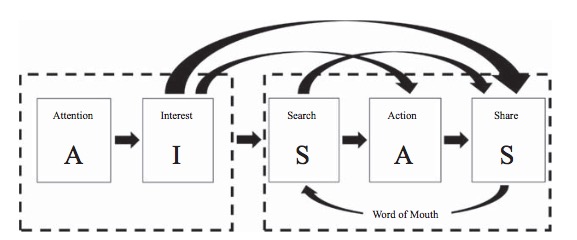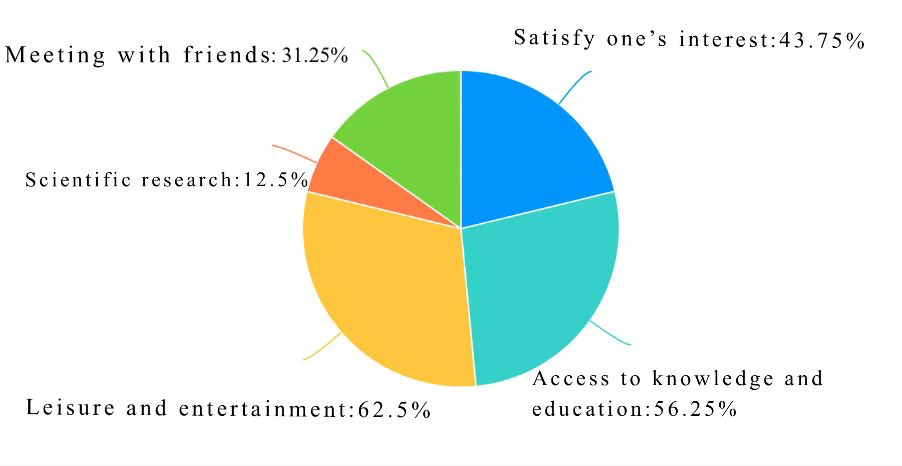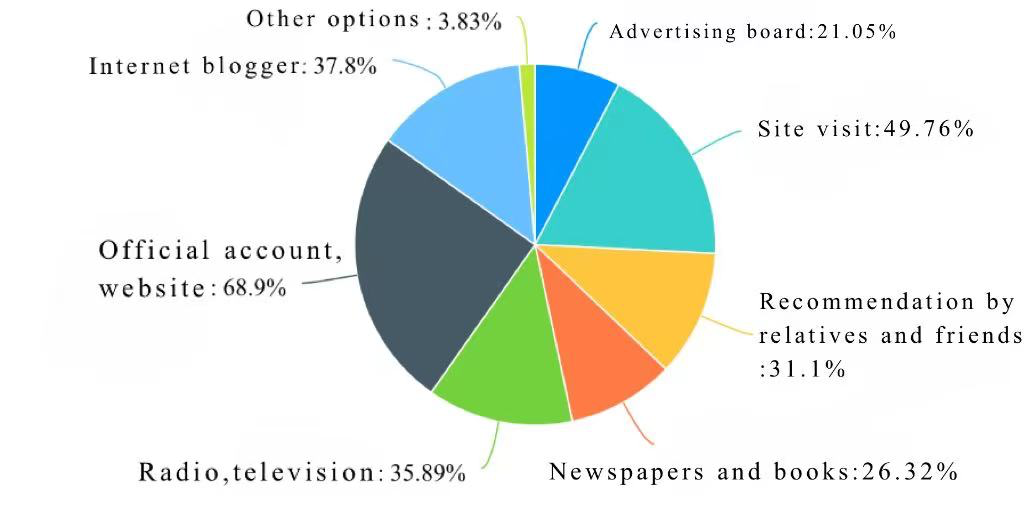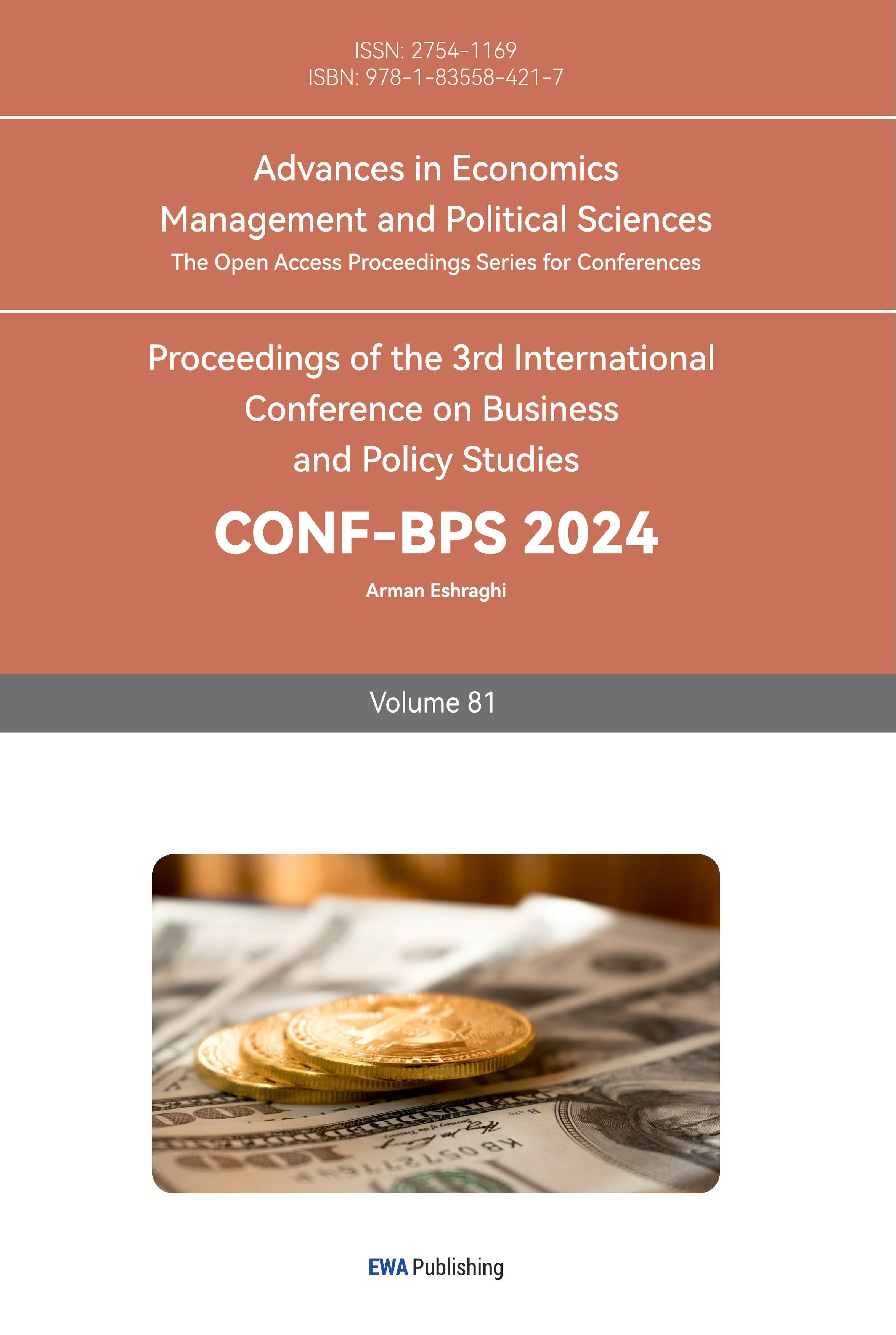1. Introduction
In recent years, with the continuous development of China's economy and the improvement of cultural confidence, the spiritual and cultural demand has increased rapidly. As an important position of historical and cultural inheritance, the museum has shown a steady development trend, and the scale of tourist consumption has continued to increase. According to the development data of Chinese museums released by the State Administration of Cultural Heritage, the total number of museums in China has reached 6,565, ranking among the highest in the world. In 2022, 34,000 offline exhibitions and nearly 230,000 educational activities were held throughout the year, receiving 578 million visitors, and nearly 10,000 online exhibitions and more than 40,000 educational activities were launched, attracting nearly 1 billion web page views and more than 10 billion new media page views, showing a strong market size, potential and new media communication characteristics. With the introduction of digital technology, museums around the world continue to strengthen the construction of new media matrix matrices such as websites and WeChat public accounts, and their communication process has also undergone great changes in terms of communication subjects, communication channels, and communication content, showing obvious network and interactive characteristics. Therefore, the consumer behavior of museums in today's era is no longer limited to passively receiving information through traditional media channels such as newspapers, magazines, radio,and television, but gradually relies on new media such as the Internet and social media to actively search for information and share consumption experience. In the new media era, consumer behavior has changed from the traditional "AIDMA" model to the "AISAS" model with network characteristics. Therefore, the AISAS model, as a new marketing model, is highly adaptable to the current brand communication of museums.
Based on the AISAS model, this study will analyze the status quo of museum brand communication through a questionnaire surveys and field visits to museums, summarize the characteristics and rules of communication, and put forward countermeasures and suggestions.
2. Review
The AISAS model is developed based on the AIDA and AIDMA models. These models focus on behavioral process-oriented, summarizing the stages of consumer behavior, to clarify how suppl- side marketers can effectively engage consumers at each stage. AIDA model is an early method to attract consumers in the field of marketing and advertising, also known as a hierarchy of effects model, which was proposed by Lewis around 1900. It specifically includes four stages: attention, interest, desire and , action [1-2]. Later, Hall developed and proposed the AIDMA model based on it, including five stages of Attention, Interest, Desire, Memory, and Action [3]. These models have been widely used in practice, but no specific research has been done in the field of new media. With the development of the Internet and the popularity of netizens, consumers are no longer passively accepting information from traditional media channels in the past, but more actively searching for information and sharing. Therefore, in 2005, Dentsu Group, an international 4A advertising company in Japan, launched a new marketing communication model, the AISAS model, based on the change of consumer behavior in the Internet era in response to the change of consumer behavior in the background of Web 2.0. The model is mainly composed of five elements: Attention, Interest, active Search, Action and, Share, as shown in Figure 1 [4]. The most obvious difference between the "AISAS" model and the traditional "AIDMA" model is that the "AISAS" model is based on the characteristics of efficient acquisition and rapid and convenient dissemination of information on the Internet in the new environment of the popularization of the Internet, social media and smartphones. Based on the "AI stage" of the traditional "AIDMA" model, there is a unique "SAS stage", that is, consumers actively search for the product or service information they want, and after the consumption behavior occurs, they can share the experience of using the product or service and make other consumers notice the shared information through various new media, thus forming a complete closed loop. In this model, the emergence of two "S" with network characteristics - Search and Share - does not blindly indoctrinate users with one-way ideas but fully reflects the impact and change of the Internet, social media, and smartphones on people's lifestyles and consumer behavior. In recent years, there has been some research using the AISAS model [5-7], but the research on museums is still relatively few, and the surveys on museum consumption behaviors in the new media era are also relatively few.

Communication with Low-Involvement (persons) Communication with High-Involvement (persons)
Figure 1: The model of AISAS
3. Methodology
This study mainly adopts the questionnaire survey method to facilitate sampling. The questionnaire was produced by "Questionnaire Star"(an applet for making questionnaire) and distributed through social network platforms from August 1 to August 15, 2023. A total of 209 questionnaires were collected, of which 209 were valid, with an effective rate of 100%. A total of 17 questions were designed in the questionnaire. Except for 3 questions involving personal statistical information, the consumption behavior of museum users was divided into five stages, namely attention, interest, search, action, and sharing, with the main reference of the AISAS model.
4. Research results
4.1. Demographic characteristics of respondents
The respondents were divided according to gender, age, education level, and occupation type. The age of the majority of audience is the youth (18-40), with 53.6 %. Moreover, there are 11.96% more females than that male. Most consumers are educated, the biggest population of education level is Postgraduate or above. In addition people who are students, employees, and professionals tend to be the main audience of museums.
4.2. Attention
The survey shows that most people(97.13%) have access to information about museums. Only 2.87%of individuals never visit or follow the museum’s exhibitions or events. This shows that the demand for museum visits is still relatively large, and the museum has generally done a good job in terms of publicity. Most people noticed the museum's activities.

Figure 2: The frequency of visiting or following exhibitions or events at the museum.
4.3. Interest
Consumers get more information through the Internet platform, such as product features, user reviews, related recommendations, etc. At this stage, consumer interest in the product or service may be further stimulated and is no longer limited to traditional advertising channels. More than 80% of people are interested in museums, while entertainment, access to knowledge and education, satisfying hobbies, meeting friends and scientific research are also reasons that consumers are interested in and willing to participate in museum activities, which shows that museums have a large proportion of customers." Entertainment and leisure" and "access to knowledge and education" were the two biggest reasons for people's interest in museums, accounting for 62.5% and 56.25% respectively. This was followed by "satisfying one's own interests", accounting for 43.75%, while meeting friends and scientific research accounted for 31.25% and 12.5% respectively.

Figure 3: People’s level of interest in the museum.

Figure 4: The reason for why people are interested in museums.
4.4. Search
After gaining interest from customers,it is important to let customers search museum information independently. According to the status,177(84.68%) people will search it independently including 22 people who search frequently.Also it is necessary for museums to focus on where to post. Not only traditional means like advertising board, broadcast, television and newspaper but also newly developed approaches such as official accounts and blogger. Recently,people usually acquire museum information through site visit and websites(more than 50%). Moreover, they still desire to acquire information through site visit and websites, but people who want to receive message through broadcasting and internet celebrities are higher than their current obtained proportion.

Figure 5: The extent to which individuals actively searched the museum.

Figure 6: General ways that people search information of museums.

Figure 7: The ways that people would like to access museum information.
4.5. Action
The questionnaire shows that most people tend to participate museum exhibitions or activities by site visit(75% of individuals placed site visit the first place, and only 1 person placed it the last place).Followed by live immersive experience like shows and costume change. The least is broadcast interaction, only 1 person claimed that this is the best way to join in museum activities. On the other hand, online participation like online exhibition hall and short videos shared a similar preferences. Overall,most people like to enjoy realistically, but they also prefer online interactions.
4.6. Share
The pie chart witnessed 95.69% of people who are willing to share museums information or their experiences including 64.59% of citizens eager to share. They tend to post relative news and photos on moments or other social medias. Oral notification is also a common way for people to share information, more than 50%.

Figure 8: The degree to which people are willing to share information about the museum.
5. Conclusion and discussion
According to the survey results, the visiting and consumption behavior process of museum consumers, which fully reflects the current Internet era, can be divided into five stages: Attention, Interest, Search, Action and Share. Therefore, as a museum organization operator, it is necessary to adopt corresponding brand communication strategies according to each stage of user behavior to enhance consumer participation and loyalty. Specific suggestions are as follows:
First of all, the museum is clearly positioned to enhance the attention index of the masses through multi-channel communication, enhanced interaction, scene restoration and other means. According to the museum's own resources, the museum's overall, thematic exhibition hall and theme exhibition are characterized by positioning, and multi-channel communication is realized. For example, the Toyota Industrial Technology Memorial Hall in Japan and the Grand Canal Museum in China are clearly positioned and highlight the unique regional history and culture. In addition to the basic exhibition, the Grand Canal Museum of China has set up a number of thematic exhibition halls closely related to the "Canal", including "Epic Scroll of the Grand Canal of China", "The Forbidden City and the Grand Canal", "Emperor Yang and the Grand Canal", "world-renowned canal and Canal cities", and the intangible cultural heritage of the Grand Canal ". In recent years, with the rise of new media such as Facebook, Twitter, Instagram, wechat, Weibo and Douyin, the integration of museums and new media has become closer, and many museums have made efforts to build new media into an important position of historical and cultural communication. The form of communication has widened from the traditional means of communication, such as radio and television, newspapers and books, and billboards to the emerging media, such as public accounts, websites, and network bloggers. At the same time, the museum can attract the attention of the public through creative exhibitions, interactive experiences, cultural activities and other ways, enhance the visual, auditory and tactile experience of the audience, and improve the brand awareness and recognition.
Second, on the basis of attracting attention, the museum needs rich content and innovative forms to further stimulate the audience's interest and make them have a good impression on the brand. For example, to stimulate the audience's interest through unique exhibition content, profound and simple interpretation, and attractive storylines; Create influential cultural and creative products through the selection of collections; Enhance experience and interaction through the integration of new digital technologies; Highlight local characteristics through uniqueness, attract local residents to trace the history of ancestors, and create a network celebrity card to attract foreign tourists; Constantly optimize the content of the museum's communication on social media, and export the museum's characteristic cultural information to the outside while maintaining a stable update frequency, taking into account both quality and quantity. For example, the British Museum Explorer mobile app at the British Museum uses augmented reality technology to allow users to interact with museum exhibits through their phones or tablets, enhancing the user's sense of engagement and experience. The British Museum has also developed an AR app called British Museum Tour, which allows users to take a virtual tour of the museum via their phone or tablet. These digital technology innovations applied to museums have greatly increased the interest of users in visiting the experience, and also brought more visitors and revenue to the museum.
Third, enrich and broaden the information channel, so as to facilitate people to search and search. For the consumer search link, a variety of search tools and channels can be provided to facilitate the audience to find relevant information. For example, search engines, navigators, voice assistants and other tools are provided to help viewers quickly find content they are interested in. At the same time, exhibits introduction, historical and cultural knowledge and other content can be published on the official website, social media and other platforms to induce the audience to search and understand. In addition, it can fully cooperate with other platforms (such as travel websites such as Ctrip, social platforms such as Dianping, short videos such as Little Red Book and Tik Tok), create accounts and push articles with relevant content, so as to facilitate users of various platforms to find information related to museums.
Fourth, after the audience's interest in and demand for the museum brand, the museum needs to provide convenient and quick booking channels and payment methods to encourage the audience to take action to buy products or services. The audience can be encouraged to buy or participate through promotional activities, membership system, etc.
For the museum has a certain attribute of public welfare, shoulder the mission of inheriting and disseminating historical and cultural knowledge, so there are many exhibitions and activities are free, but the capacity is limited. Therefore, in today's development of network and digital technology, attention can be paid to the combination of virtual and real, on-site visits and online virtual VR Tours, and the organic integration and dissemination of museum cultural relics and digital technology, so as to enhance the convenience of participation, not limited by time and space, and attract more people to join the relevant activities.
Finally, museums can encourage visitors to share their experiences through social media, word of mouth and other means, and at the same time provide good after-sales service and interactive communication platform, so that visitors can feel the sincerity and quality of the museum, so as to expand brand influence and cultivate audience loyalty. In order to promote consumer sharing behavior, museums can adopt a variety of incentive strategies. For example, by organizing interesting cultural activities and providing unique visiting experiences, the audience is willing to share their own experiences and feelings; At the same time, you can set up a photo punch area, provide social media sharing tools, etc., to facilitate the audience to share their own visit experience and exhibit photos. In addition, the audience can be encouraged to actively participate in sharing through incentives and recognition, such as offering discounts, member benefits, etc. Looking at the successful experience of the world's outstanding large museums, they all attach great importance to the public's interactive sharing experience on social media, and strive to promote museum collections into the daily communication of the public. For example, museums in Europe and the United States are very active on YouTube, Facebook, Twitter, Instagram and other social media. The Louvre, the Art Museum of Chicago, the British Museum, the Metropolitan Museum of Art, and the V&A Museum have all opened accounts on Chinese platforms such as Wechat and Weibo, pushing exhibition information, cultural relics pictures, and behind-the-scenes curatorial content. Visitors can actively discuss and share their experiences in the comments section.
References
[1]. Barry, T.E.; Howard, D.J. A review and critique of the hierarchy of effects in advertising. Int. J. Advert. 1990, 9, 121–135. [CrossRef]
[2]. Wijaya, B.S. The development of hierarchy of effects model in advertising. Int. Res. J. Bus. Stud. 2012, 5, 73–85. [CrossRef]
[3]. Hall, S.R. The Handbook of Sales Management: A Review of Modern Sales Practice and Management; McGraw-Hill Book Company: New York, NY, USA, 1924.
[4]. Satoshi Kono.From the Marketers Perspective:The Interactive Media Situation in Japan[J].Television Goes Digital,2009(1).
[5]. Abdurrahim, M.S.; Najib, M.; Djohar, S. Development of AISAS model to see the effect of tourism destination in social media. J. Apl. Manaj. 2019, 17, 133–143. [CrossRef]
[6]. Kuang, J.Q. An application study of the AISAS model-based hotel e-marketing. Appl. Mech. Mater. 2013, 241, 3224–3228. [CrossRef]
[7]. Lin-Lin Xue ; Ching-Cheng Shen; Alastair M. Morrison;Li-Wen Kuo. Online Tourist Behavior of the Net Generation: An Empirical Analysis in Taiwan Based on the AISAS Model. Sustainability 2021, 13.
Cite this article
Wang,T. (2024). Research on Museum Brand Communication Strategy Based on AISAS Model. Advances in Economics, Management and Political Sciences,81,151-158.
Data availability
The datasets used and/or analyzed during the current study will be available from the authors upon reasonable request.
Disclaimer/Publisher's Note
The statements, opinions and data contained in all publications are solely those of the individual author(s) and contributor(s) and not of EWA Publishing and/or the editor(s). EWA Publishing and/or the editor(s) disclaim responsibility for any injury to people or property resulting from any ideas, methods, instructions or products referred to in the content.
About volume
Volume title: Proceedings of the 3rd International Conference on Business and Policy Studies
© 2024 by the author(s). Licensee EWA Publishing, Oxford, UK. This article is an open access article distributed under the terms and
conditions of the Creative Commons Attribution (CC BY) license. Authors who
publish this series agree to the following terms:
1. Authors retain copyright and grant the series right of first publication with the work simultaneously licensed under a Creative Commons
Attribution License that allows others to share the work with an acknowledgment of the work's authorship and initial publication in this
series.
2. Authors are able to enter into separate, additional contractual arrangements for the non-exclusive distribution of the series's published
version of the work (e.g., post it to an institutional repository or publish it in a book), with an acknowledgment of its initial
publication in this series.
3. Authors are permitted and encouraged to post their work online (e.g., in institutional repositories or on their website) prior to and
during the submission process, as it can lead to productive exchanges, as well as earlier and greater citation of published work (See
Open access policy for details).
References
[1]. Barry, T.E.; Howard, D.J. A review and critique of the hierarchy of effects in advertising. Int. J. Advert. 1990, 9, 121–135. [CrossRef]
[2]. Wijaya, B.S. The development of hierarchy of effects model in advertising. Int. Res. J. Bus. Stud. 2012, 5, 73–85. [CrossRef]
[3]. Hall, S.R. The Handbook of Sales Management: A Review of Modern Sales Practice and Management; McGraw-Hill Book Company: New York, NY, USA, 1924.
[4]. Satoshi Kono.From the Marketers Perspective:The Interactive Media Situation in Japan[J].Television Goes Digital,2009(1).
[5]. Abdurrahim, M.S.; Najib, M.; Djohar, S. Development of AISAS model to see the effect of tourism destination in social media. J. Apl. Manaj. 2019, 17, 133–143. [CrossRef]
[6]. Kuang, J.Q. An application study of the AISAS model-based hotel e-marketing. Appl. Mech. Mater. 2013, 241, 3224–3228. [CrossRef]
[7]. Lin-Lin Xue ; Ching-Cheng Shen; Alastair M. Morrison;Li-Wen Kuo. Online Tourist Behavior of the Net Generation: An Empirical Analysis in Taiwan Based on the AISAS Model. Sustainability 2021, 13.









